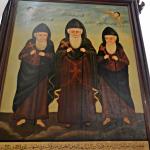![Copy of 00130[1]](https://wp-media.patheos.com/blogs/sites/224/2013/07/Copy-of-001301-211x300.jpg) The Trappists, or Reformed Cistercians are a branch of the Order of Citeaux. They possess several monasteries in America, three of which are situated in the United States. The Order took its name from the Abbey of Notre Dame de la Maison-Dieu, of La Trappe, founded in 1140 by Rotron, Count of Perche. After various viscissitudes the Abbey finally degenerated, and when near ruin God in his own wisdom, sent relief in the person of Armand Jean le Bouthillier de Rance. This celebrated man was bom in 1626, of noble family. According to an abuse, quite common in that age, the child, being destined for the Church, was loaded with preferment by his father, and though only ten years old, he was made commendatory abbot of La Trappe, and two other abbeys, prior of two priories, and canon of Notre Dame at Paris, and his income was very large. He was ordained priest in 165 1, by his uncle, the Archbishop of Tours, whose co- adjutor he hoped to become some day. However, his youthful worldliness was gradually shaken by a series of striking mishaps—the death of a cousin, his own remarkable escape from a violent death, and a disappointment to his ambition, were among the results of his entering into himself, and recognizing the vanity of the world. In 1660, he resigned all his benefices, except the Abbey of La Trappe, disposed of his patrimony, and donated the greater part of his wealth to the Hotel Dieu, or great hospital at Paris. He then repaired to La Trappe, and he determined to bring back the monastery to the first spirit of the Order of Citeaux. By degrees he introduced the most austere practices, and he himself gave the example of all that he prescribed to his religious.
The Trappists, or Reformed Cistercians are a branch of the Order of Citeaux. They possess several monasteries in America, three of which are situated in the United States. The Order took its name from the Abbey of Notre Dame de la Maison-Dieu, of La Trappe, founded in 1140 by Rotron, Count of Perche. After various viscissitudes the Abbey finally degenerated, and when near ruin God in his own wisdom, sent relief in the person of Armand Jean le Bouthillier de Rance. This celebrated man was bom in 1626, of noble family. According to an abuse, quite common in that age, the child, being destined for the Church, was loaded with preferment by his father, and though only ten years old, he was made commendatory abbot of La Trappe, and two other abbeys, prior of two priories, and canon of Notre Dame at Paris, and his income was very large. He was ordained priest in 165 1, by his uncle, the Archbishop of Tours, whose co- adjutor he hoped to become some day. However, his youthful worldliness was gradually shaken by a series of striking mishaps—the death of a cousin, his own remarkable escape from a violent death, and a disappointment to his ambition, were among the results of his entering into himself, and recognizing the vanity of the world. In 1660, he resigned all his benefices, except the Abbey of La Trappe, disposed of his patrimony, and donated the greater part of his wealth to the Hotel Dieu, or great hospital at Paris. He then repaired to La Trappe, and he determined to bring back the monastery to the first spirit of the Order of Citeaux. By degrees he introduced the most austere practices, and he himself gave the example of all that he prescribed to his religious.
When De Rance first came to the Abbey, the state of things was deplorable; the monks had ceased to live in community, and if they met at all it was for pleasure parties. De Rance had great difficulty in restoring order and regularity in the Community. Still he was unsatisfied; an ideal had been in his mind for some time in which were blended the union with God through contemplation and prayer, bodily mortification, and severance from causes of distraction. Finally the austerities of his life impaired his health, and De Rance resigned the duties of his office to Don Zozionus. He died October 20, 1700. During the eighteenth century, the Abbey of La Trappe was the edification of the Church in France, and served as a retreat for men of all ranks who desired to spend some time in solitude. In 1790, the Order was suppressed with all other congregations by the Constituent Assembly of France, but the great majority of the monks remained faithful to their vocation, and they went to Switzerland, and entered the monastery of Val Sainte, and Don Augustin was appointed superior. After God, the Order of Trappists owe their preservation to this wise and holy man. In 1806, Napoleon permitted the Trappists to return to France but later he withdrew his approval and protection for some reason, and Don Augustin fled to America, where he established two houses, which, however, did not long exist. After the fall of Napoleon, Don Augustin returned to La Trappe Abbey, and after founding several new houses, died at Lyons, July 16, 1827.
The monks of La Trappe, for the most part, resisted the sophistries of Jansenism. From the monastery of Val Sainte, Trappist filiations spread the austere rule of the Order into Spain, Belgium, Piedmont, England and Ireland.
In 1848, Trappists from the Abbey of Melleraye in France, founded the present Abbey of Gethsemani in Kentucky. The Order has also a monastery at New Melleraye, in the diocese of Dubuque, Iowa, and the Monastery of Our Lady of the Valley, Lonsdale, R. I. The mother house of the Order is at Citeaux, near Dijon, France. Don Augustin was the founder of a female branch of the Order, which he established at Bas Volais, in France, in 1786, aided by his sister. When the monks sought refuge in this country, some of the sisters came also, and founded a community, but they returned to France in a few years. There exists a Third Order of La Trappe, in which the Religious devote their lives to the education of youth. The Community of Trappist Nuns at Tracadie, Nova Scotia, belongs to this Third Order, and they follow closely the Rule of the monks.
The discipline of La Trappe is very severe, as the following account will show. In summer the Religious go to rest at eight; in winter at seven. They get up at two o’clock in the night to go to Matins, which usually last till half-past four, because they add the Office of the Blessed Virgin to the regular office, and between the two make half an hour’s meditation. After Matins, in summer time they may go and rest in their cells till Prime; in winter they go into a common room near the stove, where each reads to himself. At half-past five they say Prime, and then go to Chapter, which usually lasts half an hour. At seven they go to work; the cowl is put off, and the under garment tucked up; some dig, others carry stones—each according to the task assigned to him, for they are not free to choose the kind of work which they like best. The abbot himself works, and often takes up the most abject sort of employment. Their indoor work when the weather does not allow outdoor labor, includes carpentry, joinery, copying, binding, sweeping and other work. When they have worked an hour and a half they go to Office; Tierce is said, followed by Mass; then Sext, after which an interval of reading in their own cells is allowed. At eleven they go to the refectory—fast days an hour later. This is a large room, with a long table on each side. The Abbot’s table is laid for six; guests are entertained at it, if they ask to be present. There are no table cloths, but the tables are kept scrupulously clean. Each monk has his napkin, mug, knife, fork and spoon. The repast consists of brown bread, vegetable soup, a mess of carrots or spinach, two apples or pears, and beer or cider. At one o’clock they return to work, for an hour and a half to two hours. The recall being sounded, every monk takes off his boots, puts away his tools, puts on his cowl, and retires to his cell, where he reads and meditates until Vespers, at four o’clock. At five a collation of dry bread, fruit and beer, is served. Then there is a short rest in the cells when they go to the chapter, and listen to spiritual reading till six, when Compline is said. At seven a bell rings, and they go to their dormitories; they sleep on straw mattresses in their ordinary clothes. The most trying part of all the discipline is the strict rule of silence, no monk being allowed to talk. The Abbot and the guest master are the only persons in the convent who are permitted to speak to strangers. The dead are buried in their habits. The annual fast is from September 14th until Easter. Besides the choir brothers, who are or meant to be, priests, and the lay brothers, oblates are also received—persons who do not wish to take the vows, but conform strictly to the Rule during their residence in the monastery. Novices are received after two years probation; three years more are required for profession. There are nearly three thousand, five hundred members of the Order in the world, and fifty-five monasteries.
The life of a Trappist is a continual death to self, a continual inmolation of self-will, and the absolute obedience to the superior.
Theodore Mayhew, Henry Coyle and Frank S. Hickey, eds., Our Church, Her Children and Her Institutions (Boston: Angel Guardian Press, 1908), 138-141.











